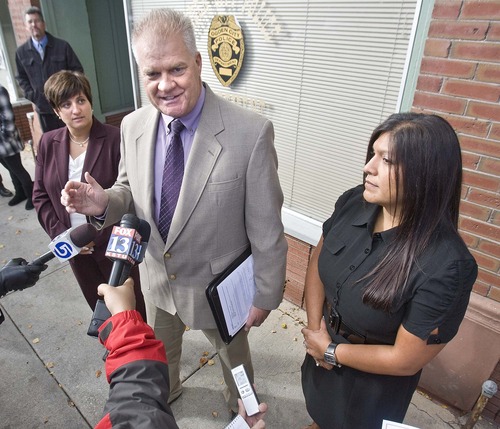This is an archived article that was published on sltrib.com in 2013, and information in the article may be outdated. It is provided only for personal research purposes and may not be reprinted.
Ogden • Gang-related crimes in Ogden have dropped by almost half during the past five years.
But authorities are unsure whether to attribute the good news more to effective police work or a controversial gang injunction statute — which may be suppressing gang activity as well as prompting gang members to move from Ogden to neighboring cities.
According to numbers released by the Ogden Police Department, gang crime in the city is at a five-year low. In 2008, officers reported 1,002 gang-related crimes, while in 2012, that number was 574.
"It is all coming together," said Lt. Scott Conley, who heads the Ogden Metro Gang Unit. "Ogden's face is changing to a safer community."
Conley said there is no single factor that has caused gang crime to decrease; rather, a community effort to suppress gang crime through prevention, suppression and intervention with gang members has helped lower the numbers.
But one effort that has been watched closely is a gang injunction that has been in effect since September 2010.
The injunction is intended to curb gang activity in Ogden by prohibiting identified Ogden Trece gang members from associating with each other in public, possessing weapons or graffiti tools, and sets an 11 p.m. curfew, among other restrictions.
Weber County prosecutors call the homegrown gang a nuisance and say the injunction is appropriate, while defense attorneys and the ACLU have fought the injunction, calling it a violation of constitutional rights.
If documented Trece members are caught violating the injunction, they can be fined or could face jail time. Since it's a civil order, it requires a lower standard of evidence than criminal proceedings.
The boundaries of the injunction, however, do not reach past city limits.
In neighboring cities, police say they've felt the effects of some gang members fleeing Ogden to avoid the injunction.
Riverdale police Lt. James Ebert said that prior to the injunction, they had about five to seven documented gang members living in the city. In recent years, the police department knows of 10 to 15 who reside there.
"We have seen a small influx of gang members that have moved into the city," Ebert said. "We have seen an increase, but not to the point that it's become an issue. It hasn't pushed crime to the point where we have become concerned about it."
According to records from the Riverdale Police Department, there were 28 gang crimes in 2009, and 14 in 2010. In 2011, officers recorded 36 gang crimes, and in 2012, 33 gang-related crimes were recorded.
Ebert said the slight increase of gang activity in Riverdale is likely due to Ogden's injunction. But he said the main crime issue within the city isn't gang life — it's shoplifting. Ebert said due to the large number of retail stores within the city, the majority of calls to police are for suspected larceny.
Another neighboring city, South Ogden, has also seen a slight increase in gang activity in recent years. In both 2009 and 2010, officers reported 12 gang crimes within city limits. In 2011, 18 crimes were reported, and in 2012, 24 crimes were recorded.
"Shortly after Ogden got all of their gang people served with the injunction, over that next following year, we saw our involvement with gang members increase," said South Ogden police Sgt. Wil DeHart. "When that initially occurred, we had a spike of gang members moving into South Ogden from Ogden City."
DeHart said officers interact with known gang members more frequently, but it is often difficult to classify their crimes as a "gang crime" or charge them with a gang enhancement. He said they've not estimated how many members have moved to their city after the injunction was issued.
In Roy, however, they have seen a decrease in gang crime, according to their records. In 2009, Roy's officers recorded 58 gang-related crimes, with a drop to 14 crimes in 2010. In 2011, they report that only five crimes were recorded, and in 2012, only one gang-related crime was reported.
Gang crime numbers from North Ogden were not available. Officer Paul Rhodes said their officers do not have the ability to flag crimes as gang-related in their current records system.
Beyond the injunction, Conley said the Ogden police department is taking other measures to help curb gang crime. He said they've partnered with Adult Probation and Parole to assist in parolee checks within city limits. They've also backed the program CROSS — Community, Re-entry, Opportunity, Social, Suppression — a court-ordered program that works with community youths to help them get away from gang life. The program acts as a sort of "one-stop shop" where participants can connect to other program partners who can offer services such as counseling, employment help or educational needs.
But Conley said there is still one facet that is hindering their efforts in thwarting gang activity in the city.
"There is one major component that is still missing," he said. "And that's the parental piece."
Conley said many parents just don't realize that their children may be associating with gang members, while others are gang members themselves and are passing down the lifestyle to their children.
The nature of gang crimes is also shifting in recent years. From 2008 to 2011, graffiti ranked as the most common gang crime. While in 2008 officers recorded 236 instances of graffiti, in 2012, only 44 graffiti crimes were recorded — a 76.2 percent decrease.
Conley said most of the gang-related crimes they have seen lately involve drug-related crimes. In 2012, 76 drug-related gang crimes were reported, with the top drug offense being possession of amphetamine drugs.
"Drugs are a nucleus to a lot of problems for law enforcement," he said.
Twitter: @jm_miller





